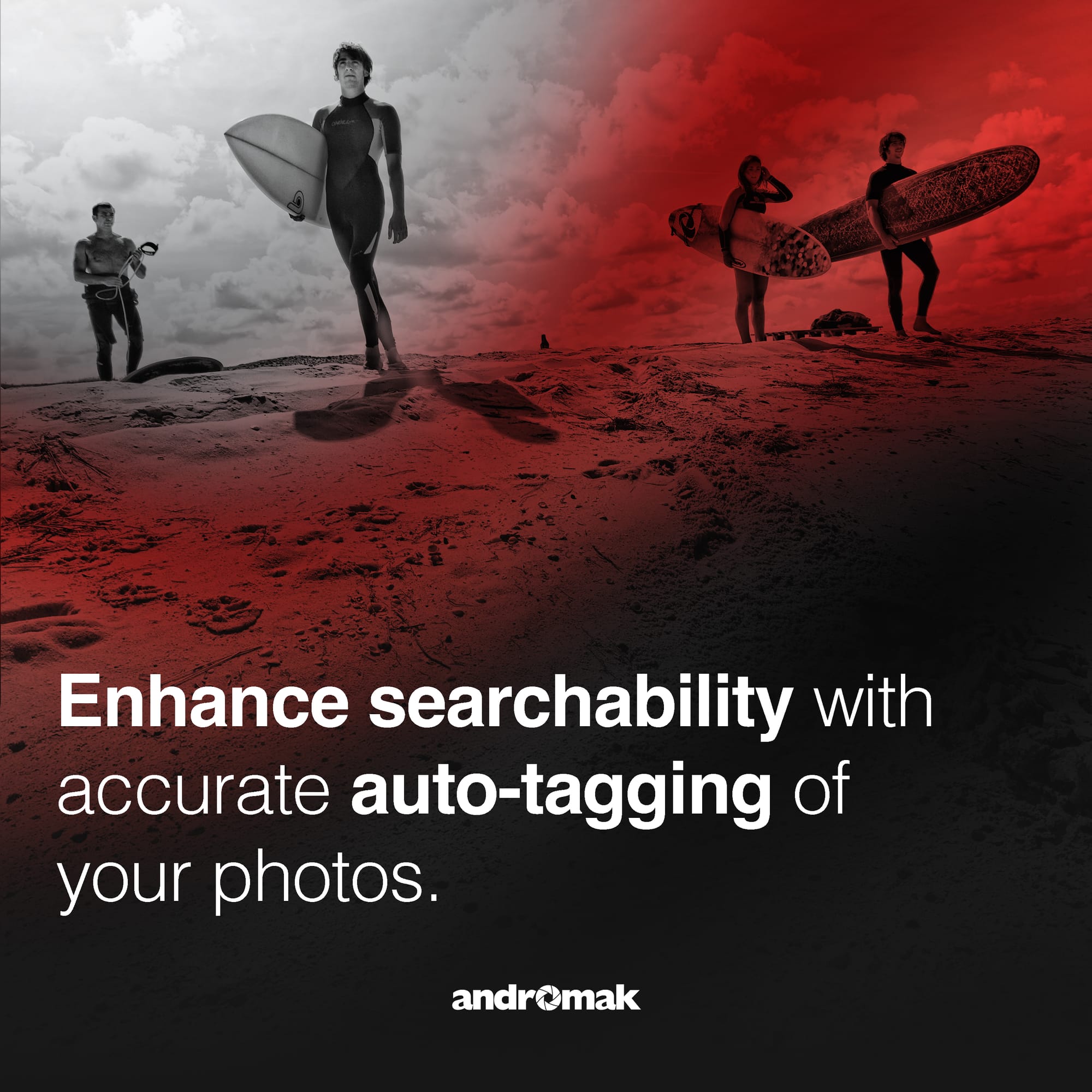In the era of digital photography, managing vast collections of images can be a daunting task. Auto tagging, powered by advanced artificial intelligence, offers a transformative solution for photographers, enabling efficient organization and searchability of their photo libraries. This article explores the benefits of auto tagging, delves into the technology behind it, and examines how platforms like Andromak are leveraging this innovation to enhance the workflow and creativity of photographers.

The digital revolution has democratized photography, making it accessible to anyone with a smartphone or camera. This surge in the number of images captured daily has led to a new challenge: managing and organizing these vast collections. Traditional methods of manually tagging photos are time-consuming and often inconsistent. Enter auto tagging—an AI-driven solution that automatically identifies and tags elements within photos, transforming how photographers organize and access their work. This article examines the benefits of auto tagging, the technology behind it, and how platforms like Andromak are utilizing this innovation to streamline the workflow of photographers.
The Challenge of Image Management
With the exponential growth in digital photography, photographers—both amateur and professional—face the daunting task of managing thousands of images. Effective organization is crucial not only for efficiency but also for preserving the ability to find and utilize specific images when needed.
Manual Tagging: A Laborious Process
Manual tagging involves assigning keywords to photos, describing elements such as the subject, location, and context. While effective, this method is labor-intensive and prone to human error. Inconsistent tagging can lead to difficulties in retrieving images and hinder the overall workflow.
The Need for Automation
The sheer volume of digital photos necessitates an automated solution. Auto tagging addresses this need by leveraging AI to analyze and tag images accurately and consistently. This technology not only saves time but also enhances the searchability and usability of photo libraries.

How Auto Tagging Works
Auto tagging uses advanced algorithms and machine learning techniques to analyze the content of images and assign relevant tags. This process involves several key steps:
Image Recognition
The AI system first processes the image using deep learning models trained on vast datasets. These models can recognize various elements within the photo, such as objects, people, scenes, and even emotions.
Tag Assignment
Once the elements are identified, the system assigns tags based on the recognized features. These tags are typically keywords that describe the content and context of the image, making it easy to categorize and search.
Continuous Learning
One of the strengths of AI is its ability to learn and improve over time. As the system processes more images, it becomes better at recognizing and tagging new elements, continually enhancing its accuracy and efficiency.

Benefits of Auto Tagging for Photographers
Time Efficiency
Auto tagging significantly reduces the time spent on organizing and tagging photos. What used to take hours or even days can now be accomplished in minutes, freeing up photographers to focus more on their creative work.
Consistency and Accuracy
AI-driven tagging provides a level of consistency and accuracy that is difficult to achieve manually. This ensures that all photos are tagged uniformly, making it easier to search and retrieve images based on specific criteria.
Enhanced Searchability
With accurate and consistent tags, photographers can quickly locate specific images within their libraries. This enhanced searchability is particularly beneficial for professionals who need to access their work on demand.
Creative Freedom
By automating the tedious task of tagging, auto tagging allows photographers to devote more time to their creative pursuits. This can lead to increased productivity and the opportunity to explore new creative avenues.

Andromak's Auto Tagging Feature
Andromak is at the forefront of integrating auto tagging technology into its platform, offering photographers a seamless and efficient way to manage their image collections.
User-Friendly Interface
Andromak provides an intuitive interface that makes auto tagging accessible to photographers of all skill levels. The platform guides users through the process, ensuring that their photos are tagged quickly and accurately.
Integration with Existing Workflows
Andromak’s auto tagging feature integrates seamlessly with photographers’ existing workflows. Users can upload their images, and the system automatically processes and tags them, without disrupting their normal operations.
Real-Time Tagging
One of the standout features of Andromak’s auto tagging is its real-time capability. As images are uploaded, they are immediately analyzed and tagged, allowing photographers to continue working without delay.
Customizable Tagging
Andromak allows photographers to customize the tagging process according to their specific needs. Users can set preferences for the types of tags assigned and even add their own custom tags to enhance the system’s functionality.

Case Studies and Applications
To illustrate the impact of auto tagging, consider the following case studies:
Case Study: A Wedding Photographer
Emma, a wedding photographer, struggled with managing thousands of images from different events. Using Andromak’s auto tagging feature, she was able to organize her photos efficiently. The system tagged images with keywords like “bride,” “groom,” “ceremony,” and “reception,” making it easy for Emma to compile albums and find specific shots for her clients. The time saved allowed her to take on more projects and enhance her creative portfolio.
Application: Stock Photography
In the stock photography industry, quickly finding and categorizing images is crucial. Auto tagging can significantly streamline this process. Photographers can upload their images to stock photo platforms that use AI tagging, ensuring their work is easily discoverable by potential buyers searching for specific themes or subjects.

The Future of Auto Tagging in Photography
As AI technology continues to evolve, the potential applications for auto tagging in photography are vast and exciting. Here are some future directions:
Improved Accuracy and Detail
Future advancements in AI and machine learning will lead to even greater accuracy and detail in auto tagging. Systems will be able to recognize more nuanced elements within images, such as specific emotions, interactions, and artistic styles.
Personalized Tagging
AI could become more personalized, learning the unique preferences and styles of individual photographers. This customization will allow for tags that are tailored to each photographer’s specific needs and creative vision.
Integration with Other Technologies
Auto tagging is likely to integrate with other emerging technologies, such as augmented reality (AR) and virtual reality (VR). This integration could create new opportunities for interactive and immersive photo management and viewing experiences.
Auto tagging represents a significant leap forward in the management and organization of digital images. By leveraging advanced AI technology, photographers can streamline their workflows, enhance the searchability of their photo libraries, and focus more on their creative pursuits. Platforms like Andromak are leading the way in making auto tagging accessible and effective for photographers of all levels.
In a world where the volume of digital images continues to grow, auto tagging offers a practical and powerful solution to one of the biggest challenges in photography. Embracing this technology can help photographers stay organized, efficient, and ultimately more creative.

References
- "How AI is Revolutionizing Photo Management," Forbes. [Source](https://www.forbes.com/sites/forbestechcouncil/2020/12/01/how-ai-is-revolutionizing-photo-management/)
- "The Benefits of AI in Photography," PetaPixel. [Source](https://petapixel.com/2021/01/01/the-benefits-of-ai-in-photography/)
- "Natural Language Processing: An Introduction," Towards Data Science. [Source](https://towardsdatascience.com/natural-language-processing-an-introduction-9c0a6f22c97d)
- "AI and the Future of Photography," AI News. [Source](https://www.ainews.com/ai-and-the-future-of-photography/)





